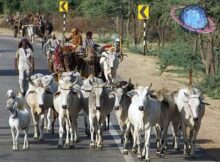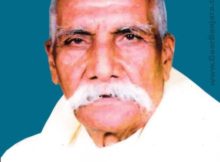Marathas and Gor Banjaras
Almost all kings have taken benefit of the transport facility provided by the Gor Banjara tribe. Chhatrapati Shivaji Maharaj came to meet Aurangzeb at Agra in 1666. They had 500 oxen and 100 Banjara with them. They were even able to fight depending on the situation. Shivaji Maharaj used a huge herd of oxen for goods transport when he looted Surat in 1664 and 1670.
The ancestors of Thakasingh Naik from Bushanpur were also working as bodyguards of Shivaji. Bajirao Peshwa, after returning Delhi in 1730, halted at Bhopal. At that time Nizam put a seize around Bhopal city. Durgadas Banjara refused to transport goods for the Nizam. Ultimately the Nizam was forced to lift the seize. Bajirao Peshwa was very much pleased with Durgadas. He brought Durgadas to Pune and honoured him (Chandakaleen Bundelkhand by Dr. Ayodhya Prasad Pandey, page 130).
Gor Banjaras were in service of Marathas. After the entry of British the profession of supplying material to armies subsided. Moguls and Nizams had given waste lands on large scale to British to make them cultivable. The Waste Land Rules 1865 had given rights to Naiks to collect the agriculture cess along with the landlords. Also government posts like Police Patil in rural area were given to Naiks.
In North India, especially Central Province, the Banjaras were highly placed in government courts at par with Samants and landlords. The Gors from Indukhi were related to courts of Orchha, Panna and Delhi. Gorvamshi Baghraj to Tagsingh ruled in this region up to their 16 generations. The Mughal Emperor had awarded Jahagir of 52 villages to them. The Indukhi region was given to Kriparam Gor.
The references to this effect are found in the history of their 8th generation Pahad Singh and Bhagat Singh. Later on Shinde won the Jahagiri of Indukhi and then Gor Tandas came to settle at Neemraja in Datiya region (Bundelkhand Ki Poorva Riyasatomein Pandulipiyonka Sarvekshan by Dr. Kamani, page 24). The Tandas of Gor Banjara used to halt in Delhi area since many years. Lakhishah Gor Banjara owned thousands of acre land in Paharganj Raisina area.
When the 9th Guru of Sikhs, Guru Teg Bahadur was martyred in 1675 the Banjara did not allow the enemy to take the head and body of the Guru and Lakhishah Banjara put his Raiseena Tanda on fire and consigned the body of the Guru to flames. This incident is highly revered in the Sikh religion. It lead to very close relations between the Sikhs and Gor Banjaras.
Some Gor Banjaras adopted Sikh religion during that time. Lakhishah Banjara owned hundreds of acres of land in Delhi till the British arrived on which the buildings now standing on almost the 300 acres of land from Paharganj to Secretariat, Parliament House and other government offices belonged to Gor Banjara Tandas. The Rakabganj Gurudwara is testimony to the above mentioned event.
The land in Mahavir Nagar, Najafgarh, Bhadola, Ranapratap Bagh settlements once belonged to Gor Banjara and now encroached upon by others. This means the Gor Banjaras had a powerful sit in Delhi at that time. It was an important trade center for them. The Gor Banjara also ruled mountain areas in Punjab, Madhya Pradesh, Rajasthan, Gujarat and Uttar Pradesh. Numbers of Tandas owned forestlands in Khair, Pilibhiti and Gorakhpur area of Uttar Pradesh.
The Arjun Naik Banjara had a small state of its own comprising 155 villages till 1788. There is a big city named after a Tanda in Sitapur district. While the Jaitpur district comprises towns named after Gor Badshahpur and Banjarapur, which have huge markets. Piriya Banjara of Pilibhit was a big landlord. He built the magnificent Pilibhit. Gor Banjara have established the city of Devaria. The Tanda of Jahajor Naik was situated in the mountain forest of this region. He had 82,141 acre land of his own. He used to deposit Malgujari for this land with British till 1900 (Banjara Samaj by Dr. Sharma, pages 12, 17, 100). Also the Kripa Singh Gor had the title of mountain region in the Satpuda range. The palace built by King Vijay Singh Naik during British region in East Gujarat is still there.
That means the Gor Banjara tribe ruled in some states from 1st Century till the departure of British. Later on the tribe has preserved its legacy in the form of chiefs of army in the courts of kings and later as landlords. This glorious history of Gorvamshiyas was unknown till date. Therefore we can conclude that Gors are Kshatriyas. They are not Banjara, nor Rajputs and also not traders.
They are Aryans, basically Hindus. The Tandas were not nomadic in nature rather used to settle down at a place. The men used to return to the Tanda after the trade. This is a tribe without a class, which was engaged in herding, agriculture, and transport of goods according to changing times.
Freedom Fighter and Patriot: Govind Guru Banjara
The occupation of Banjara tribe ceased to exist after the arrival of Railway in India. It lead to extinction of many Tandas. Govind Guru Banjara revolted against the British, who, according to him were responsible for destroying the Tandas and hence should be driven out of the country. He established a religious sect called Lasodia (Lawadiga) and united people to revolt against the British through the saints and sages. He spread a great deal of awareness especially among the Bhils in the mountain region of Gujarat like Durgapur, Banswada, Sudhrapur, Panchmahal and Kheda.
Once upon a time the Bhils had a big Kingdom of their own in the region. In order to regain the Kingdom by driving out the British out of the country Govind Guru aroused the feeling of patriotism among them. Lakhs of Bhils became his followers. He made them his disciples with a Deeksha and laid down a strict daily regimen for them, which included abstinence from liquor and non-vegetarian food, taking a daily bath and chanting the name of lord Rama.
He used stories from Ramayana and Mahabharata to inculcate a sense of patriotism among them. Thousands of people started pouring in to see him. He built up an Ashram at Manavgarh in the forests.
In the night of Diwali in 1913 he called all his followers together at Manavgarh. Thousand of Bhils gathered with their bows and arrows and other weapons. They decided to attack on a nearby camp of British in the night. The British got information about the gathering of lakhs of people in the jungle that night. Colonel Shutton put up a seize around Manavgarh with all his men and machinery.
A fierce battle followed. Around 2 thousand people died in the firing. Gauging the situation Govind Guruji ordered his followers to hide in the forest and himself surrendered to Colonel Shutton. He was ordered to be hanged till death. The enraged lakhs of Bhils then took to the streets. It forced the British to change the sentence awarded to Govind Guru to Kalapani. There are instances of numerous such warriors from Banjara Tandas but their history remained unknown till date. We can say that Gors were in forefront even during the freedom struggle.(Continued…)









